Ancient Civilisations | History - Mesopotamian Civilisations | 9th Social Science : History : Ancient Civilisations
Chapter: 9th Social Science : History : Ancient Civilisations
Mesopotamian Civilisations
Mesopotamian Civilisations
Mesopotamia refers to the region of Iraq and Kuwait
in West Asia. Several kingdoms emerged around the city states of this region
from the early third millennium BCE. The Sumerian, Akkadian, Babylonian and
Assyrian civilisations flourished in Mesopotamia.
Geography
In the Greek language, meso means ‘in between’ and potamus
means river. The Euphrates and Tigris flow here and drain into the Persian Gulf
is since this area is in between two rivers it is known as Mesopotamia. The
northern part of Mesopotamia is known as Assyria, and the southern part is
called Babylonia.
The Sumerians
The oldest civilisation in Mesopotamia belonged to
the Sumerians. The Sumerians were the contemporaries of the people of Indus and
Egyptian civilisations. These civilisations had trade connections. The
Sumerians settled in the Lower Tigris valley around 5,000 to 4,000 BCE. They
are believed to have originated from Central Asia. They founded many cities and
Nippur was one of the important cities. They developed the cuneiform writing
system. During the early phase of the Sumerian civilisation, kings acted as the
chief priests. Their political domination came to an end by 2450 BCE.
The Akkadians
The Akkadians dominated Sumeria briefly from 2450
to 2250 BCE. The Sargon of Akkad was a famous ruler. Sargon and his descendants
(ca.2334–2218 BCE) ruled Mesopotamia for more than hundred years. In the
cuneiform records of Akkadians, mention is made about the Indus civilisation.
The documents of
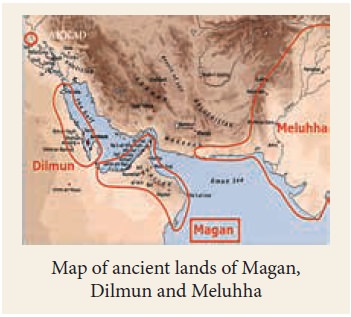
Sargon of Akkad (2334–2279 BCE) refer to the ships
from Meluhha, Magan and Dilmun in the quay of Akkad.
The Babylonians
The Semitic people called Amorites from the Arabian
desert moved into Mesopotamia. They were known as Babylonians as they
established a kingdom and made Babylon its capital. By the time of the king
Hammurabi, they extended their domination to the western part of Mesopotamia.
The powerful states of Ur (2112 to 2004 BCE) and Babylon (1792 to 1712 BCE)
controlled this region. The hero Gilgamesh referred to in the first ever epic
on the earth may have been a king of Sumeria. Hammurabi, the sixth king of
Babylon belonging to the first Amorite dynasty (1792–1750 BCE), attained fame
as a great law-maker.
Assyrians
The Assyrian Empire was politically active in
Mesopotamia around 1000 BCE. The Assyrian kings were the priests of Ashur, the
chief deity of Assyria. The Assyrian government was controlled
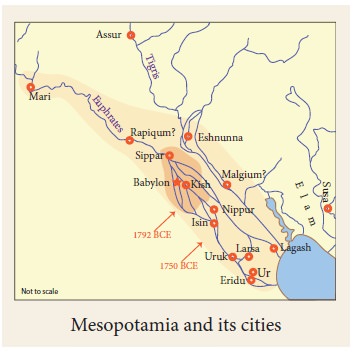
by the emperor and provincial governors were
appointed by the emperor to administer provinces. Assur was the capital city of
Assyria. Ashurbanipal was popular ruler of the late or neo-Assyrian empire (ca.
668 to 627 BCE). He maintained a famous library of cuneiform records. Assyrians
worshipped the deity of Lamassu for protection.
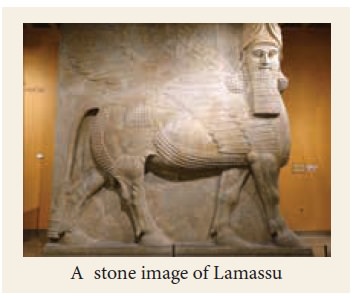
Society, State and Administration
The Sumerian civilisation had many city states. A
typical Sumerian city was surrounded by cultivable lands. The fortified
Sumerian cities had the temples called Ziggurats at its centre. The temple was
controlled by the priests. Priests, scribes and nobles were part of the
government. The rulers and priests occupied the top of the social hierarchy.
The ruler performed the role of the chief priest. The scribes, merchants and
artisans were placed next in the hierarchy. The scribes maintained the account
of the taxes and the priests collected the taxes. The temples acted as
storehouses of the taxed commodities. Assemblies were created for the
administration of the state. Cultivable lands were owned by the kings and the
higher classes of people in the hierarchy. The peasants who remained attached
to the temples in the earlier phase of Mesopotamian civilisation became free
from that association in the later period. Not all people were allowed to live
in the cities.
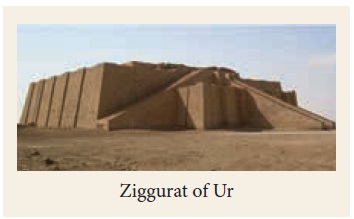
Food and Agriculture
Agriculture was the main occupation of the
Mesopotamians. They had developed irrigation systems for ensuring the
availability of water for agriculture and cultivated wheat, barley, onions,
turnips, grapes, apples and dates. They domesticated cattle, sheep and goats.
Fish was part of their diet.
Trade and Exchange
Trade was an important economic activity of the
Mesopotamian society. Traders assisted in the exchange of goods procured from
the potters and artisans. They traded with Syria and Asia Minor in the west,
and in Iran and the Indus Valley civilisation in the east. They travelled in
ships across the seas for trade. Their temples acted as banks and lent credit
on their own account. The Mesopotamian documents have references to loan and
repayment, with or without interest. Perhaps this is the first written evidence
of charging an interest on borrowed money.
Cities and Town Planning
The Mesopotamian cities featured mud or baked brick
walls with gates. Some people lived in reed huts outside the cities. The
Ziggurats were at the city centre on a platform and appeared like steep
pyramids, with staircases leading to the top. Around this temple were complexes
of ceremonial courtyards, shrines, burial chambers for the priests and
priestesses, ceremonial banquet halls, along with workshops, granaries,
storehouses and administrative buildings.
Religion
Sumerian religion was polytheistic. They worshipped
several gods and goddesses. Sumerians did not pay much attention to the life
after death and so they did not build pyramids like the Egyptians. The
Sumerians prayed to Enlil, the god of sky and wind. The city of Nippur was
centre of Enlil’s worship. Ninlil was the Sumerian goddess of grain. The
Babylonians worshipped Marduk, and Ashur was the supreme god of the Assyrians.
Ishtar was goddess of love and fertility, Tiamat the god of the sea and chaos,
and Sin, the moon god. The kings were
seen as representatives of the
gods on earth. The Mesopotamians developed a rich collection of myths and
legends. The most famous of these is the epic of Gilgamesh, which is written in
the cuneiform text. It contains a legend of the flood and has similarities with
the account of Noah’s Ark mentioned in the Bible and other myths in the Hindu puranas.
Hammurabi’s Law Code
Hammurabi Code is an important legal document that
specifies the laws related to various crimes. It has 282 provisions specifying
cases related to family rights, trade, slavery, taxes and wages. It is carved
on a stone, which portrays Hammurabi as receiving the code from the Sun god
Shamash. It was a compilation of old laws based on retributive principles. The
‘eye for eye’ and ‘tooth for tooth’ form of justice is used in the Hammurabi
Code.
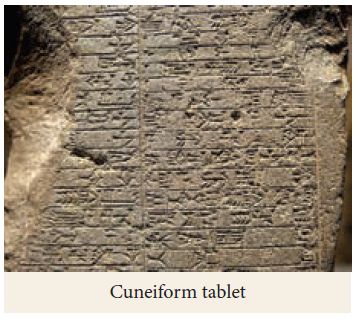
Cuneiform: The Sumerian Writing System
Cuneiform is the Sumerian writing system. The shape
of the letter is in the form of wedge and hence it is called cuneiform.
Evolving around 3000 BCE, it is one of the earliest scripts of the world. The
epic of Gilgamesh was written in this script. They used this script for
commercial transactions and writing letters and stories. The clay tablets
contain loads of information on the Sumerian civilisation.

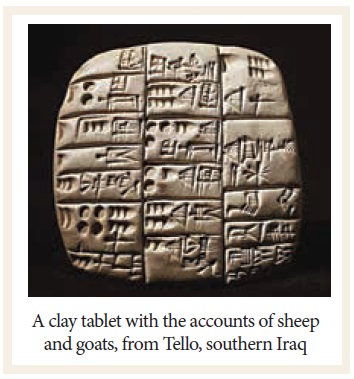
Art
The Mesopotamian art included sculptures in stone
and clay. A few paintings and sculptures from the Mesopotamian times have
survived today. Mesopotamian sculptures portray animals, such as goats, rams,
bulls and lions. Some mythological figures like lions and bulls with human head
have also been found in their art. Massive sculptures were created at the time
of Assyrian and Babylonian empires.
Science
The Mesopotamians excelled in mathematics,
astronomy and medicine. They developed the concepts of multiplication, division
and cubic equation. The numerical system based on 60 was conceived by them.
They were the ones to formulate the 60-minute hour, the 24-hour day and the
360° circle. The Sumerian calendar had seven days in a week. Their numerical
system had place values. They created the water clock and the lunar calendar
based on the movement of the moon. They developed methods for measuring areas
and solids. They also developed advanced weight and measurement systems.
They introduced the twelve month calendar system
based on lunar months. Their ideas influenced Greek astronomy. They had
developed a medicinal system as well. A text called the Diagnostic Handbook,
dated to the 11th century BCE
Babylon, lists symptoms and prognoses. This indicates their scientific
understanding of herbs and minerals.
Contributions of the Mesopotamian Civilisation
·
The invention of the potter’s wheel is credited to the Sumerians.
·
They developed the calendar system of 360 days and divided a circle into 360 units.
·
The cuneiform system of writing was their contribution.
·
The Hammurabi’s law code was another legacy of the Mesopotamians.
Related Topics